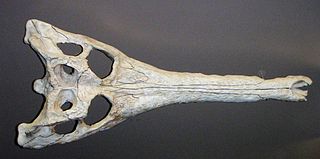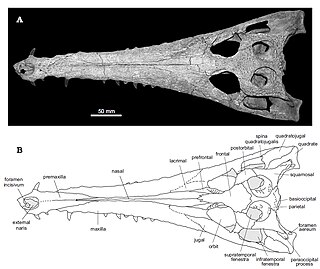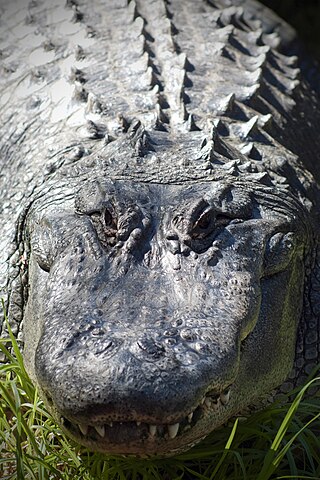
Gavialinae is a subfamily of large semiaquatic crocodilian reptiles, resembling crocodiles, but with much thinner snouts. Gavialinae is one of the two major subfamilies within the family Gavialidae - the other being the subfamily Tomistominae, which contains the false gharial and extinct relatives.

Gavialidae is a family of large semiaquatic crocodilians with elongated, narrow snouts. Gavialidae consists of two living species, the gharial and the false gharial, both occurring in Asia. Many extinct members are known from a broader range, including the recently extinct Hanyusuchus. Gavialids are generally regarded as lacking the jaw strength to capture the large mammalian prey favoured by crocodiles and alligators of similar size so their thin snout is best used to catch fish, however the false gharial has been found to have a generalist diet with mature adults preying upon larger vertebrates, such as ungulates.

Tomistoma is a genus of gavialid crocodilians. They are noted for their long narrow snouts used to catch fish, similar to the gharial. Tomistoma contains one extant (living) member, the false gharial, as well as potentially several extinct species: T. cairense, T. lusitanicumT. coppensi, and T. dowsoni. However, these species may need to be reclassified to different genera as studies have shown them to be paraphyletic, for example: previously assigned species T. taiwanicus from Taiwan, is reclassified to the genus Toyotamaphimeia, and T. dowsoni should be excluded from Tomistoma based on phylogenetic analysis.

Toyotamaphimeia is a genus of extinct gavialid crocodylian which lived in Japan and Taiwan during the Middle Pleistocene. A specimen recovered in 1964 at Osaka University during the construction of a new science building has been dated to around 430–380 thousand years old based on the stratum in which it was found. Toyotamaphimeia was a fairly large crocodylian measuring approximately 6.3–7.3 metres (21–24 ft) long. Two species are named, T. machikanensis from Japan and T. taiwanicus from Taiwan, both originally described as members of the genus Tomistoma.

Gavialosuchus is an extinct genus of gavialoid crocodylian from the early Miocene of Europe. Currently only one species is recognized, as a few other species of Gavialosuchus have since been reclassified to other genera.

Megadontosuchus is an extinct monospecific genus of gavialoid crocodylian, traditionally regarded as a member of Tomistominae, from the middle Eocene of Italy. Fossils have been found from Monte Duello in the province of Verona. The genus is currently monotypic, with the type and only species being Megadontosuchus arduini. The species was originally named in 1880, although it was assigned to the genus Crocodilius. The genus was first erected by paleontologist Charles C. Mook in 1955 along with the genus Kentisuchus, which was also first classified as Crocodilius. No holotype for Megadontosuchus was designated in 1880, and a lectotype wasn't proposed until 2007.
Dollosuchoides, colloquially known as the Crocodile of Maransart, is an extinct monospecific genus of gavialoid crocodilian, traditionally regarded as a member of the subfamily Tomistominae. Fossils have been found in the Brussel Formation of Maransart, Belgium and date back to the middle Eocene.

Dollosuchus is an extinct monospecific genus of tomistomine crocodilian originally named as a species of Gavialis. It is a basal form possibly related to Kentisuchus, according to several phylogenetic analyses that have been conducted in recent years, and is the oldest known tomistomine to date. Fossils have been found from Belgium and the United Kingdom. It had large supratemporal fenestrae in relation to its orbits, similar to Kentisuchus and Thecachampsa.
Eogavialis is an extinct genus of eusuchian crocodylomorph, usually regarded as a gavialoid crocodylian. It superficially resembles Tomistoma schlegelii, the extant false gharial, and consequently material from the genus was originally referred to Tomistoma. Indeed, it was not until 1982 that the name Eogavialis was constructed after it was realised that the specimens were from a more basal form.

Eosuchus is an extinct genus of eusuchian crocodylomorph, traditionally regarded as a gavialoid crocodilian. It might have been among the most basal of all gavialoids, lying crownward of all other known members of the superfamily, including earlier putative members such as Thoracosaurus and Eothoracosaurus. Fossils have been found from France as well as eastern North America in Maryland, Virginia, and New Jersey. The strata from which specimens have been found date back to the late Paleocene and early Eocene epochs.
Maroccosuchus zennaroi is an extinct gavialoid crocodylian from the Early Eocene of Morocco, traditionally regarded as a member of the subfamily Tomistominae.
Paratomistoma is an extinct monospecific genus of gavialoid crocodylian. It is based on the holotype specimen CGM 42188, a partial posterior skull and lower jaw discovered at Wadi Hitan, Egypt, in Middle Eocene-age rocks of the Gehannam Formation. The skull is unfused but considered morphologically mature. Paratomistoma was named in 2000 by Christopher Brochu and Philip Gingerich; the type species is P. courti in honor of Nicholas Court, who found CGM 42188. They performed a phylogenetic analysis and found Paratomistoma to be a derived member of Tomistominae, related to the false gharial. It may have been a marine or coastal crocodilian.

Penghusuchus is an extinct genus of gavialid crocodylian. It is known from a skeleton found in Middle to Upper Miocene rocks of Penghu Island, off Taiwan. The taxon was described in 2009 by Shan and colleagues; the type species is P. pani. It may be related to two other fossil Asian gavialids: Toyotamaphimeia machikanensis of Japan and Hanyusuchus sinensis of South China. It was a medium-sized gavialid with an estimated total length of 4.5 metres (15 ft).

Crocodyloidea is one of three superfamilies of crocodilians, the other two being Alligatoroidea and Gavialoidea, and it includes the crocodiles. Crocodyloidea may also include the extinct Mekosuchinae, native to Australasia from the Eocene to the Holocene, although this is disputed.

Thecachampsa is an extinct genus of gavialoid crocodylian, traditionally regarded as a member of the subfamily Tomistominae. Fossils have been found from the eastern United States in deposits of Miocene age. Those named in the 19th century were distinguished primarily by the shape of their teeth, and have since been combined with T. antiquus. More recently erected species were reassigned from other genera, although their assignment to Thecachampsa has since been questioned.
Gryposuchinae is an extinct subfamily of gavialid crocodylians. Gryposuchines lived mainly in the Miocene of South America. However, "Ikanogavialis" papuensis may have survived more recently, into the Late Pleistocene/Holocene. Most were long-snouted coastal forms. The group was named in 2007 and includes genera such as Gryposuchus and Aktiogavialis, although a 2018 study indicates that the group might be paraphyletic and rather an evolutionary grade towards the gharial.

Gavialoidea is one of three superfamilies of crocodylians, the other two being Alligatoroidea and Crocodyloidea. Although many extinct species are known, only the gharial Gavialis gangeticus and the false gharial Tomistoma schlegelii are alive today, with Hanyusuchus having become extinct in the last few centuries.

Tomistominae is a subfamily of crocodylians that includes one living species, the false gharial. Many more extinct species are known, extending the range of the subfamily back to the Eocene epoch. In contrast to the false gharial, which is a freshwater species that lives only in southeast Asia, extinct tomistomines had a global distribution and lived in estuaries and along coastlines.

Brevirostres is a paraphyletic group of crocodilians that included alligatoroids and crocodyloids. Brevirostres are crocodilians with small snouts, and are distinguished from the long-snouted gharials. It is defined phylogenetically as the last common ancestor of Alligator mississippiensis and Crocodylus niloticus and all of its descendants. This classification was based on morphological studies primarily focused on analyzing skeletal traits of living and extinct fossil species, and placed the gharials outside the group due to their unique skull structure, and can be shown in the simplified cladogram below:
Tomistoma cairense is an extinct species of gavialoid crocodilian from the Lutetian stage of the Eocene era. It lived in North East Africa, especially Egypt. Remains of T. cairense have been found in the Mokattam Formation, in Mokattam, Egypt. Tomistoma cairense did not have a Maxilla process within their lacrimal gland, whereas all extant (living) crocodilians do.


















